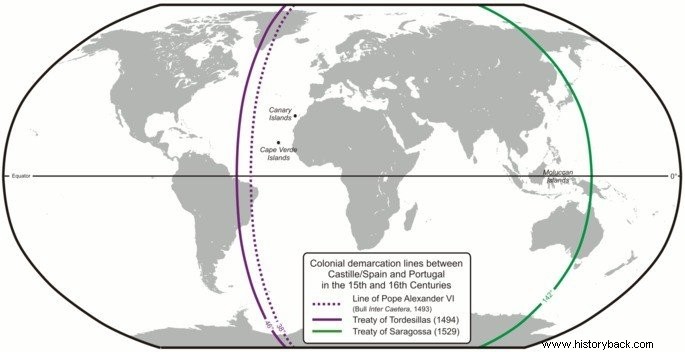The Treaty of Tordesillas was an agreement between the kingdom of Portugal and the kingdom of Castile, celebrated on June 7, 1494, in the city of Tordesillas (Spain).
By this treaty, Castilians and Portuguese divided the new world, through a meridian 370 leagues west of the Cape Verde Archipelago, in Africa. The eastern part would belong to Portugal, and the western part to Spain.
History of the Treaty of Tordesillas
The kingdoms of Castile (Spain) and Portugal were pioneers in maritime-commercial expansion in the 15th and 16th century and there was a dispute between the two crowns for possession of the new territories.
In this way, the two kingdoms signed several treaties in order to decide who owned the new lands. The first of these was the Treaty of Alcáçovas (1479) which drew a parallel from the Canary Islands. Thus, the regions discovered in the north would be Castile and those in the south, Portugal.
However, this perspective changed with the arrival of Christopher Columbus in America in 1492. That is why the Bull "Inter Coetera" was signed in 1493 and the Treaty of Tordesillas in 1494, which replaced the parallel with a meridian.
The Treaty of Tordesillas expanded the lands established by Bula Inter Coetera. Portuguese diplomacy managed to increase the meridian limit from 100 to 370 leagues west of the Cape Verde Archipelago in Africa.

Faced with the signing of the Treaty of Tordesillas, countries such as France, Holland and England questioned the division of land between Castile and Portugal. In this way, they set up expeditions to attack the territories already occupied by the Portuguese and Spanish.
End of the Treaty of Tordesillas
The limit established by the Treaty of Tordesillas fell into disuse when there was the Iberian Union (1580-1640). At this time, both Portugal and its possessions became part of the Spanish Crown. The Portuguese settlers did not need to stay only on the coast and began to venture into the interior of the territory.
With this expansion, it was necessary to redo the limits of the American colonies between the two countries, which occurred through the Treaty of Madrid, in 1750.
Bula Inter Coetera
On May 4, 1493, Pope Alexander VI signed the Bull "Inter Coetera" (Latin, "among others").
This document established an imaginary line 100 leagues west of the Cape Verde Archipelago in Africa. Thus, the lands located to the west of the meridian would be Spanish, and those to the east would be Portuguese.
However, the Portuguese Crown was unhappy with the agreement, as the established limit made it difficult for Portuguese navigations in the Atlantic Ocean. The following year, Dom João II, King of Portugal, asked for the treaty to be reformulated and obtained its modification in Tordesilhas.
Consequences of the Treaty of Tordesillas
With the Treaty of Tordesillas, the Portuguese guaranteed part of the American lands in the Southern Hemisphere.
In fact, King Dom João II's insistence on revising the Bull "Inter Coetera", for some historians, is pointed out as proof that the Portuguese knew that there was already land in this region.
Therefore, Pedro Álvares Cabral's expedition, in 1500, would also have the mission of confirming whether this assumption was true or not.
Fun facts about the Treaty of Tordesillas
- In the current configuration of Brazil, the Tordesilhas line would pass from Belém (PA) Pará, to the city of Laguna (SC).
- Considering that a sea league was 5.5 kilometers, the Tordesillas Treaty line would be 2,035 kilometers from Cape Verde.
We have more texts on the subject for you :
- Christopher Columbus
- Exercises Colonial Brazil
- Hereditary captaincies
- Iberian Union
